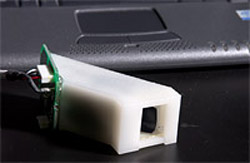Georgia Tech develops technology for more compact, inexpensive spectrometers

A prototype spectrometer made using Georgia Tech’s new technology. This spectrometer can be plugged into a lap top and used for environmental sensing.
New technology allows for more versatile portable spectrometers
Being the delicate optical instruments that they are, spectrometers are pretty picky about light.
But Georgia Tech researchers have developed a technology to help spectrometers — instruments that can be used as the main parts of sensors that can detect substances present in even ultra-small concentrations — analyze substances using fewer parts in a wider variety of environments, regardless of lighting. The technology can improve the portability while reducing the size, complexity, and cost of many sensing and diagnostics systems that use spectrometers. The technology has appeared in Applied Optics, Optics Express and Optics Letters and was presented as an invited talk at the IEEE Lasers and Electro-Optics Society Annual Meeting 2005.
Conventional spectrometers have multiple parts — a narrow slit, a lens (to guide light), a grating (to separate wavelengths), a second lens and a detector (to detect the power at different wavelengths). The Georgia Tech team’s goal was to combine all these pieces into two parts, a volume hologram (formed in an inexpensive piece of polymer) and a detector, to create a compact, efficient and inexpensive spectrometer that could be used for multiple spectroscopy and sensing applications.
“This technology is very useful for low-end spectrometers, but at the same time, there are many applications that require high-end spectrometers. This technology could convert a portion of a complex, high-end system into a much more versatile and light system,” said Ali Adibi, head of the project and an associate professor in the School of Electrical and Computer Engineering.
Because of its light weight and relative insensitivity to optical alignment, the new design helps create more versatile and portable spectrometers for several applications where portability had been difficult. For instance, the technology would make hand held devices possible for carbon monoxide detection or on-the-spot blood analysis and other biomedical applications.
One of the key advantages to the new spectrometer is its insensitivity to alignment. Spectrometers are very sensitive to the direction and wavelength of light and several of their parts are devoted to keeping the light correctly directed.
But the Georgia Tech team was able to incorporate those necessary alignments along with the focusing functions into a volume hologram. This hologram is recorded by the interference pattern of two beams in a piece of photopolymer.
“There were lots of challenges because the light we need to analyze is diffuse in nature,” Adibi said.
Conventional spectrometers work the best under collimated light (i.e. light moving in only one direction). However, the optical signal needed for practical sensing applications is diffuse. This problem is solved in conventional spectrometers by blocking light in all but one direction using a slit and a lens, but this also results in considerable power loss and lower efficiency.
“By choosing the appropriate hologram, we have no collimating hardware in our system. We have further demonstrated the capability of improving the throughput by using more complex holograms, which are recorded similar to less complex holograms, in our spectrometer without adding to the actual complexity of the system,” Adibi added.
The Georgia Tech team has a prototype for a lower-end spectrometer comparable to those currently on the market but for a considerably lower cost, Adibi said. Their research will now focus on developing more complex systems by using specially designed volume holograms to improve the efficiency — and thus the sensitivity — of the spectrometers, Adibi added.
The Georgia Institute of Technology is one of the nation’s premiere research universities. Ranked ninth among U.S. News & World Report’s top public universities, Georgia Tech educates more than 17,000 students every year through its Colleges of Architecture, Computing, Engineering, Liberal Arts, Management and Sciences. Tech maintains a diverse campus and is among the nation’s top producers of women and African-American engineers. The Institute offers research opportunities to both undergraduate and graduate students and is home to more than 100 interdisciplinary units plus the Georgia Tech Research Institute. During the 2004-2005 academic year, Georgia Tech reached $357 million in new research award funding. The Institute also maintains an international presence with campuses in France and Singapore and partnerships throughout the world.
Media Contact
More Information:
http://www.icpa.gatech.eduAll latest news from the category: Physics and Astronomy
This area deals with the fundamental laws and building blocks of nature and how they interact, the properties and the behavior of matter, and research into space and time and their structures.
innovations-report provides in-depth reports and articles on subjects such as astrophysics, laser technologies, nuclear, quantum, particle and solid-state physics, nanotechnologies, planetary research and findings (Mars, Venus) and developments related to the Hubble Telescope.
Newest articles

Machine learning algorithm reveals long-theorized glass phase in crystal
Scientists have found evidence of an elusive, glassy phase of matter that emerges when a crystal’s perfect internal pattern is disrupted. X-ray technology and machine learning converge to shed light…

Mapping plant functional diversity from space
HKU ecologists revolutionize ecosystem monitoring with novel field-satellite integration. An international team of researchers, led by Professor Jin WU from the School of Biological Sciences at The University of Hong…

Inverters with constant full load capability
…enable an increase in the performance of electric drives. Overheating components significantly limit the performance of drivetrains in electric vehicles. Inverters in particular are subject to a high thermal load,…





















